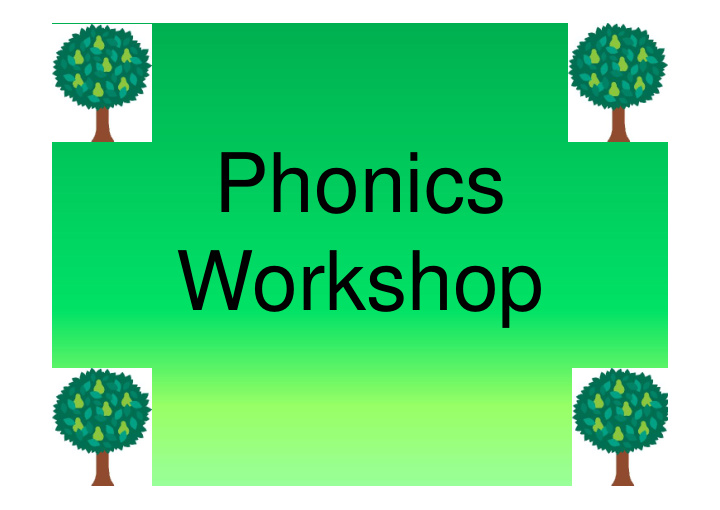



Phonics Workshop
Aims of workshop To understand the importance of phonics. To get an idea of how phonics is taught in school and understand the vocabulary we use. To understand the progression through phonic phases and how to support and develop children’s learning. What can I do at home?
• Phonics has been promoted by the government as the best way to boost reading standards • Introduction of the phonics screening in year 1. • The phonics approach teaches children to decode words by sounds, rather than recognising whole words
Phonics Consists of: • Identifying sounds in spoken words • Recognising the common spellings of each phoneme. • Blending phonemes into words for reading. • Segmenting words into phonemes for spelling.
Progression Reception • Phase 1, 2, 3 and 4 • How to blend and segment Year 1 • Phase 5 • Finding alternative ways to represent phonemes. E.g, ai, ay, a_e • Applying blending and segmenting securely Year 2 • Spelling rules/patterns such as: Silent Letters, homophones, suffixes
Blending • Recognising the letter sounds in a written word, for example c-u-p and merging or ‘blending’ them in the order to pronounce the word ‘cup’ Metal Mike Phoneme fingers
Segmenting • ‘Chopping Up’ the word to spell it out • The opposite of blending • Identifying the individual sounds in a spoken word (e.g. h-i-m , s-t-or-k) and writing down letters for each sound (phoneme) to form the word.
A Phoneme This is the smallest unit of sound in a word. How many phonemes can you hear in cat ?
A grapheme These are the letters that represent the phoneme. Children need to practise recognising the grapheme and saying the phoneme that it represents. How many graphemes can you see in the word cat?
A grapheme Graphemes are not only made with 1 letter, they can be made with more. Either way, the grapheme will still only make 1 phoneme. sick light Grapheme with 2 letters = digraph Grapheme with 3 letters = trigraph
Tricky words or spellings • Words that are not phonically decodeable • e.g. was, the, I • Some are ‘tricky’ to start with but will become decodeable once we have learned the harder phonemes • e.g. out, there,
The 44 phonemes /b/ /d/ /f/ /g/ /h/ /j/ /k/ /l/ /m/ /n/ /ng/ /p/ /r/ /s/ /t/ /v/ /w/ /y/ /z/ /th/ /th/ /ch/ /sh/ /zh/ /a/ /e/ /i/ /o/ /u/ /ae/ /ee/ /ie/ /oe/ /ue/ /oo/ /ar/ /ur/ /au/ /er/ /ow/ /oi/ /air/ /ear/ /ure/
This is where it gets tricky! • Phonemes are represented by graphemes. • A grapheme can consist of 1, 2 or more letters. • A phoneme can be represented/spelled in more than one way ( cat, kennel, click) • The same grapheme may represent more than one phoneme ( me, met)
Articulation Short oo Long oo This is one reason why the English c oo k sp oo n Language is tricky! b oo k m oo n l oo k ball oo n Children won’t grasp this overnight or by h oo k sm oo thie osmosis…they need to be immersed in an awareness of Spoken Sound Soft Sound language throughout th e th ink the day. th at th in th ere th ick th is th umb
Your turn • How many phonemes are in these words. Discuss together and write down your answer. • shelf • dress • sprint • string
Did you get it right? • shelf = sh – e – l – f = 4 phonemes • dress = d - r - e – ss = 4 phonemes • sprint = s – p – r – i – n – t = 6 phonemes • string = s – t – r – i – ng = 5 phonemes
How can I help at home? - practise the phonemes the children have learnt at school - go on grapheme or words hunts - look for tricky words/spellings in books you are reading at home - Encourage your child to segment words independently and not copy the words that you write.
Useful web sites • http://www.amblesideprimary.com/ambleweb/literacy.htm • www.bbc.co.uk/schools/websites/4_11/site/literacy.shtml • www.ictgames.com/literacy.html • www.phonicsplay.co.uk • https://www.gov.uk/government/uploads/system/uploads/att achment_data/file/190599/Letters_and_Sounds_-_DFES- 00281-2007.pdf
Time to play!
Aims of workshop To understand the importance of phonics. To get an idea of how phonics is taught in school and understand the vocabulary we use. To understand the progression through phonic phases and how to support and develop children’s learning. What can I do at home?
Recommend
More recommend